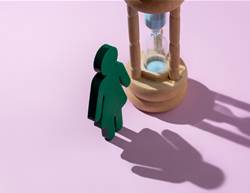When nutritionist Faye James started to get hot flushes and gain weight, she knew that it wasn’t as a result of her diet – or was it? After all, she was a nutritionist who practiced what she preached. But the more she investigated, the more she realised that women’s nutrition needs shift significantly during perimenopause and that’s something not enough of us know.
James started creating meals that catered to her changing needs. “I was interested in redesigning everyday recipes, as it were,” she said.
Her collection of nutritious everyday meals is now packed into a mouth-watering recipe book The Menopause Diet.
Here are her top three foods to avoid in menopause.
1. Reduce red meat, increase protein
Protein is more important than ever as we age, as it helps to maintain muscle mass, reports the CSIRO. Plus if we meet our protein intake, we’re less likely to overeat unnecessary kilojoules/calories and put on weight, according to The University of Sydney.
“The good news is that it appears very small changes to the diet in terms of prioritising protein, reducing fats and carbohydrates and being physically active could make a big difference in the long-term,” says Professor David Raubenheimer, head of the Nutrition Theme at the Charles Perkins Centre.
A juicy steak is not the only way to pump up the protein. When James, a mother of two, was approaching menopause, she reduced her intake of red meat, swapping it for vegetarian options like tofu and tempeh.
“To be honest with you, I do make the kids their own meaty versions because they're growing. But when we hit our mid 40s, we really need to stop growing.
“We need to look at alternative ways get our protein consumption without sort of the sort of added problems that come with having lots of red meat", like a diet high in saturated fat.
Soy is not only a good source of protein, it also contains phytoestrogens, which may help menopause symptoms in some women, reports Jean Hailes.
2. Dial back the heat
James also recommends easing up on spices.
“I love spicy foods, but they [can] exacerbate your symptoms, particularly if you experience hot flushes.”
Although there’s not a lot of evidence of the link between spicy food and hot flushes, some women do find it a trigger. Plus the sweating and flushing that comes from a chilli-packed curry is probably the last thing a woman experiencing menopause needs.
“Stick to mild spices like basil, cumin, coriander, and turmeric, which will still add flavour without heat,” says James.
3. Cut back on sugar
A diet high in sugar and fat can worsen menopause symptoms. So limiting sugar and processed foods will not only help you maintain your weight, it may also help to reduce your symptoms.
James has found alternative ways to cater to her sweet tooth without resorting to sugar. In her recipe book, The Menopause Diet, she has lots of recipes for sweet treats. However, they use clever swaps to reduce their carb load, such as almond meal instead of white flour and monk fruit extract instead of sugar.
“You can substitute sugar with monk fruit extract which has zero sugar. [Or you can use] maple syrup or coconut sugar, that although are still sugars they won't spike your sugar levels as much as they have a lower GI and are higher in nutrients than table sugar.”
For your diet in menopause, the focus should be on “whole foods, such as lean protein, plenty of veggies, fresh fruit and wholegrains and pulses, which will all aid in energy and mood levels,” says James.
Discover more about what James learned about eating well in perimenopause in this episode of Thriving in Menopause.
Listen to the full episode here.
Or download from your favourite podcast platform.








.png&h=193&w=250&c=1&s=1)



